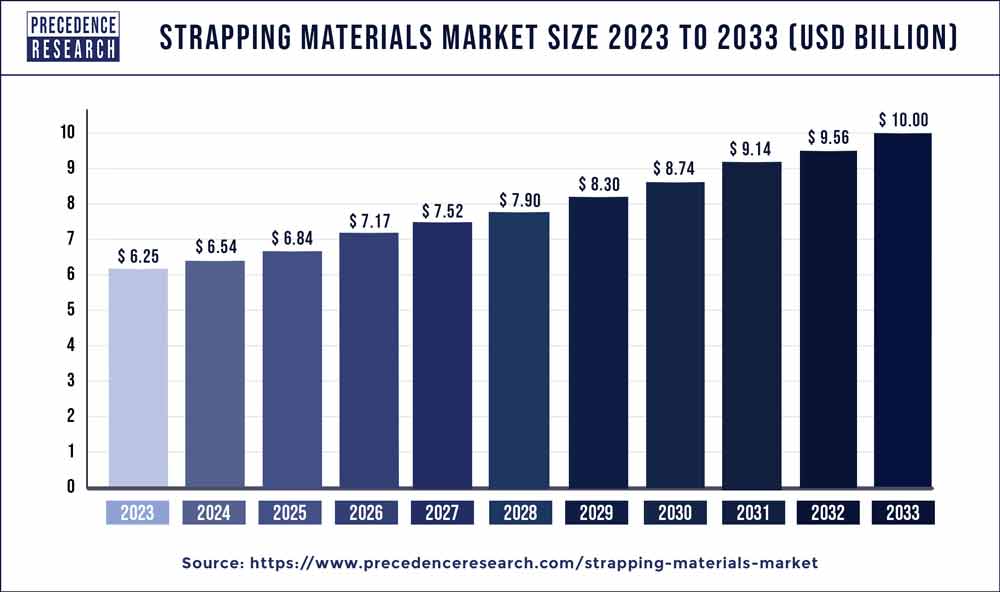Strapping Materials Market Size Will be USD 10 Bn By 2033
The global strapping materials market size is predicted to surpass around USD 10 billion by 2033 from USD 6.25 billion in 2023, rising at a CAGR of 5.10% from 2024 to 2033.
Key Takeaways
- Asia-Pacific contributed more than 46% of market share in 2023.
- North America is estimated to expand the fastest CAGR between 2024 and 2033.
- By product, the polypropylene (PP) segment generated over 48% of market share in 2023.
- By product, the polyester segment is anticipated to grow at a remarkable CAGR of 6.8% between 2024 and 2033.
- By application, the industrial logistics and warehouse segment generated over 29% of the market share in 2023.
- By application, the food & beverage segment is expected to expand at the fastest CAGR over the projected period.

The Strapping Materials Market is a dynamic sector that plays a crucial role in packaging and securing goods for transportation and storage. Strapping materials encompass a variety of materials such as steel, plastic, and polyester, designed to bind and reinforce loads. As global trade continues to expand, the demand for efficient and reliable strapping solutions has seen a significant uptick. This market serves industries ranging from logistics and manufacturing to agriculture and construction, reflecting its diverse applications.
Get a Sample: https://www.precedenceresearch.com/sample/3681
Growth Factors
Several factors contribute to the growth of the Strapping Materials Market. The increasing volume of international trade and the need for secure packaging to prevent damage during transit are primary drivers. Additionally, the growing awareness of sustainable packaging solutions has led to innovations in eco-friendly strapping materials. The rise of e-commerce and the subsequent surge in parcel shipments further fuel the demand for robust strapping solutions, creating ample growth opportunities for market players.
Trends
In recent years, key trends have shaped the Strapping Materials Market. One notable trend is the adoption of technologically advanced strapping materials, including RFID-enabled straps for enhanced tracking and monitoring during the supply chain process. Another trend is the focus on lightweight and high-tensile strength materials, aiming to reduce packaging weight and improve overall efficiency. Additionally, customization options, such as branded and color-coded strapping, are gaining popularity, meeting the unique branding needs of businesses.
Region Snapshot
The Strapping Materials Market exhibits regional variations based on industrial activities and economic growth. Developed regions, such as North America and Europe, witness a steady demand due to established manufacturing and logistics sectors. Meanwhile, emerging economies in Asia-Pacific are experiencing rapid growth, driven by increased industrialization and a surge in export activities. Each region presents distinct challenges and opportunities, influencing the market dynamics on a global scale.
Strapping Materials Market Scope
| Report Coverage | Details |
| Growth Rate from 2024 to 2033 | CAGR of 5.10% |
| Global Market Size in 2023 | USD 6.25 Billion |
| Global Market Size by 2033 | USD 10 Billion |
| Asia-Pacific Market Size in 2023 | USD 2.87 Billion |
| Asia-Pacific Market Size by 2033 | USD 4.80 Billion |
| Base Year | 2023 |
| Forecast Period | 2024 to 2033 |
| Segments Covered | By Product and By Application |
| Regions Covered | North America, Europe, Asia-Pacific, Latin America, and Middle East & Africa |
Read More: Refractories Market Size to Worth USD 51.46 Bn By 2033
Recent Developments in the Strapping Materials Market
- In March 2023, EAM-Mosca Corp., a subsidiary of Mosca GmbH, unveiled a sales and marketing partnership with Spain’s Reisopack S.L. Per the agreement, EAM-Mosca exclusively offers Reisopack’s strapping systems and OEM parts to clients in the United States, Mexico, Canada, and Brazil.
- In December 2022, Signode launched a new BST battery-powered tool designed for sealless strapping, enhancing load security and stability for heavy-duty tension requirements.
- In February 2023, Samuel Son & Co. announced the inauguration of a cutting-edge 350,000-square-foot Greenfield facility in Mexico, strategically positioned to cater to the growing needs of its expanding customer base.
Competitive Landscape:
The Strapping Materials Market is characterized by the presence of several key players competing for market share. Established companies often focus on expanding their product portfolios through technological advancements and strategic partnerships. New entrants leverage innovation to introduce novel strapping solutions. The competitive landscape is also shaped by factors like pricing strategies, distribution networks, and customer service. As sustainability becomes a key concern, companies emphasizing eco-friendly strapping solutions gain a competitive edge in the market.
Strapping Materials Market Companies
- Signode Packaging Systems
- Crown Holdings, Inc.
- Polychem Corporation
- FROMM Packaging Systems
- Samuel, Son & Co., Limited
- Dynaric, Inc.
- Mosca GmbH
- Teufelberger
- Auto Strap India
- Linder Seevetal
- PAC Strapping Products, Inc.
- Strapex Group
- Midfield Industries
- Messersì Packaging S.r.l.
- Dubose Strapping, Inc.
Segments Covered in the Report
By Product
- Steel
- Polypropylene (PP)
- Polyester (PET)
By Application
- Food & Beverage
- Industrial Logistics & Warehouse
- Corrugated Cardboard & Paper
- Newspaper & Graphics
- Building & Construction
- Metal
By Geography
- North America
- Europe
- Asia-Pacific
- Latin America
- Middle East and Africa
Contact Us:
Mr. Alex
Sales Manager
Call: +1 9197 992 333
Email: sales@precedenceresearch.com
Web: https://www.precedenceresearch.com
Blog: https://www.expresswebwire.com/
Blog: https://www.uswebwire.com/
Blog: https://www.dailytechbulletin.com/
Blog: https://www.autoindustrybulletin.com/
